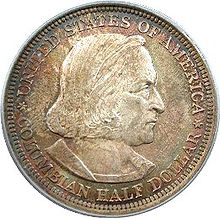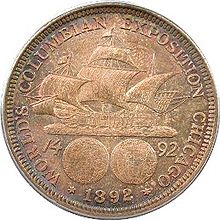- Columbian Exposition half dollar
-
Half Dollar United States Value 0.5 U.S. dollars Mass 12.5 g (0.40 troy oz) Diameter 30.61 mm (1.20 in) Thickness 2.15 mm (0.08 in) Edge Reeded Composition 90.0% Ag
10.0% CuYears of minting 1892–1893 Catalog number KM 117 Obverse 
Design Right-facing portrait of Columbus flanked by the legends UNITED STATES OF AMERICA and COLUMBIAN HALF DOLLAR. Designer Charles E. Barber Design date 1892–1893 Reverse 
Design Port view of the Santa Maria above two hemispheres flanked by the date 1492. WORLD'S COLUMBIAN EXPOSITION CHICAGO encircles the rim with the mintage date at bottom. Designer George T. Morgan Design date 1892–1893 The Columbian Exposition half dollar is a commemorative coin minted to raise funds for the World's Columbian Exposition held in 1893, and to commemorate the quadricentennial of the first voyage of Christopher Columbus to the Americas
Contents
Design
Obverse
The original intent was for Ulrich S.J. Dunbar to design the coin. Dunbar created a plaster model based on a portrait of Columbus painted by Lorenzo Lotto in 1512, but this was abandoned when Charles E. Barber, Chief Engraver of the U.S. Mint, dismissed Dunbar and secured the project for himself.[1] Barber's obverse design was based on a bust by Olin Levi Warner[2]
The obverse depicts a right-facing portrait of Columbus flanked by the legends UNITED STATES OF AMERICA and COLUMBIAN HALF DOLLAR.
Reverse
Barber clashed with Exposition officials over the reverse, favoring his own design of the Western Hemisphere covering the entire reverse. Exposition officials wanted a depiction of Columbus' flag ship Santa María poised over two hemispheres. Seeking to absolve himself of the argument, Barber delegated the task to his Assistant Engraver, George T. Morgan.[1]
The reverse features a port view of the Santa María above the Western and Eastern hemispheres, which are flanked by the date 1492. WORLD'S COLUMBIAN EXPOSITION CHICAGO encircles the rim, and the mintage date (1892 or 1893) is displayed near the bottom of the reverse.
Production
It was initially the hope of the Exposition commission that 40 million pieces be struck. However, only 5 million were ultimately authorized. For this reason, surcharge was set at fifty cents, bringing the total cost for purchase of the commemorative to one dollar. The Columbian Half Dollar was minted exclusively at the Philadelphia Mint. Mintage began on November 19, 1892.
Proof strikes numbered 103 for the 1892 issue, three of which were the 400th, 1,492nd and 1,892nd coins struck. This was in recognition of the 400th anniversary of Columbus' voyage, the year of the voyage and the year of the anniversary respectively.[1]
The first Columbian half dollar struck was sold to the Remington Typewriter Company for $10,000 in a publicity stunt which garnered attention during the Exposition. The president of the Columbian Exposition, H.N. Higinbotham, originally intended for Remington to receive a business strike half dollar, but Commissioner Col. James Ellworth successfully campaigned to have a proof coin struck for the event. other proofs were distributed to dignitaries and other Exposition officials. An unknown quantity of half-dollars were used as collateral against loans made to the Exposition by banks. When the Exposition failed to repay the debt, the banks dumped the coins into circulation.[1]
Date Mint mark Mintage[3] Proofs 1892 None 950,000 103[n. 1] 1893 None 4,052,105[n. 2][4][n. 3] - ^ Proof mintage is added to the total mintage
- ^ 2,501,700 melted
- ^ 2,105 pieces retained for metallurgical assay
See also
- Columbian Exposition quarter dollar – The quarter dollar commemorative also minted for the exposition.
- Early United States commemorative coins – A list of United States commemorative coins produced between 1892 and 1953.
- Columbian Issue – A series of Postage stamps issued to mark the exposition.
References
Bibliography
Swiatek, Anthony (1993). Commemorative Coins of the United States. Sidney, OH: Coin World. ISBN 0944945139.
Yeoman, R.S. (2010). A Guide Book of United States Coins (63rd ed.). Atlanta, GA: Whitman Publishing, LLC. ISBN 0794827675.
External links
- H.I.P. Pocket Change Web Site - Columbus Day US Mint Website
Categories:- Commemorative coins of the United States
- World's Columbian Exposition
Wikimedia Foundation. 2010.
